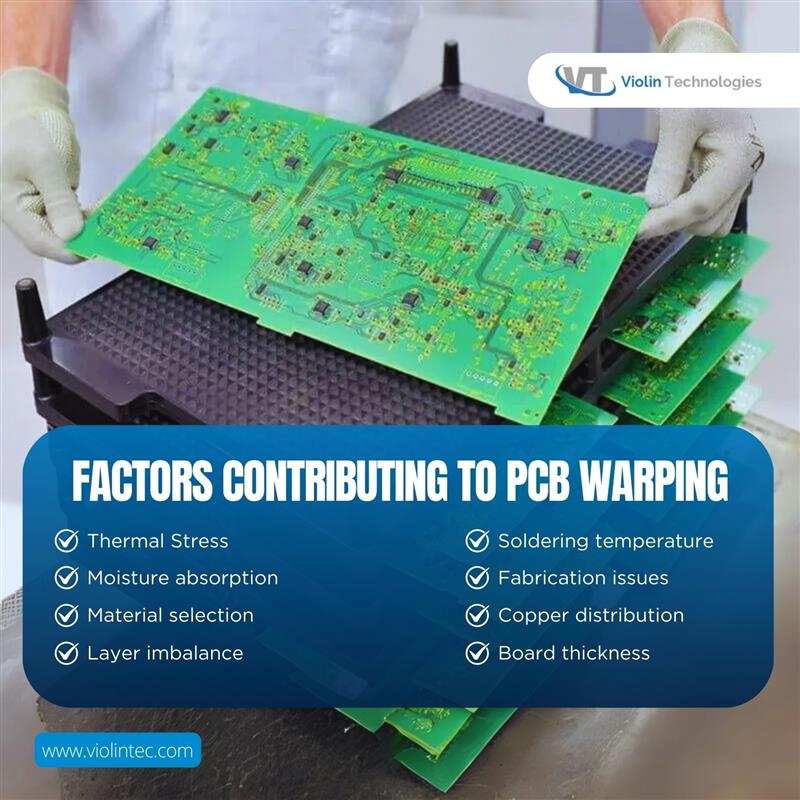Understand PCB Warping
PCB warping refers to unwanted twisting or bending of a printed circuit board, leading to misshapen boards or uneven surfaces. It inhibits the mounting of components, causes stress during soldering, and often leads to early failure of the entire system. PCB flatness is part of quality control, and particularly with automated assembly, it has been an essential requirement.
Primary Factors Contributing to PCB Warping
In engineering processes, PCB warping may result from factors singularly or in combination. A well-thought-out plan may help minimize these factors.
1. Thermal Stress
Warping is most often caused by uneven heat distribution during the soldering process, whether assembly or wave soldering. The various layers of a given PCB undergo expansion and contraction at an unequal rate due to sudden cooling or heating.
2. Moisture Absorption
PCBs, specifically those made using FR-4, tend to absorb moisture at the I—and II-level classification. During the heating phase of the soldering process, trapped moisture gets vaporized, creating internal pressure that leads to circuit bending or blistering.
3. Material Selection
Substrate materials are an integral part of a PCB as they determine their efficacy upon exposure to heat and other mechanical stresses. Injecting incompatible or low-grade materials will create discontinuities, rendering warp control difficult.
4. Layer Imbalance
Internal tension can occur when the laminate or copper layers are not balanced in multilayer PCBs. The imbalance between layers is among the main contributors to circuit board deformation over time.
5. Soldering Temperature
Exposing the PCB to a reflow soldering profile that is not in line with optimal parameters will increase the undesirable thermal stress on the PCB. Rapid changes can lead to loss of flatness due to a change of position or expansion of the layers at differing rates.
6. Fabrication Issues
Manufacturing defects, such as inconsistent lamination, defective pressing, or abnormal curing, normally cause manufacturing defects that are subsequently felt as warping.
7. Copper Distribution
The inhomogeneous copper distribution between PCB layers causes thermal expansion imbalances. When subjected to heat, heavier copper areas expand more than the lighter areas and twist.
8. Board Thickness
Thin boards are also easily bent during handling, assembly, or shipping. While cutting material and storage costs, thinner boards carry greater risks of PCB warping.
Contract manufacturers in India are on the cutting edge and placing intense emphasis on preventive design and environment controls to ensure high-yield PCB operation.

Preventive Solutions for PCB Warping
Understanding the root causes enables proactive solutions to reduce or prevent warping. Here is how manufacturers can prevent warp at the PCB design and production level.
- Choose Materials Accordingly: Emphasize material selection with stable thermal expansion properties. High-value materials resist better at high temperatures and reduce risks of moisture-based expansion.
- Optimize PCB Design: Proper PCB design can minimize warping to the maximum. Symmetrical copper layout and stack-up counteract internal stresses. Avoid excessive use of copper on one side of the board if it is not equally balanced on the other.
- Control the Assembly Process: Carefully supervise the assembly process, particularly cooling and heating gradients. Use careful thermal profiling for uniform heat flow distribution.
- Regulate Storage Conditions: Boards should be stored in regulated conditions to prevent moisture absorption and uptake. Desiccant packaging, vacuum sealing, and regulated humidity are necessary to protect board integrity before assembly.
- Inspect Fabrication Practice: Partner with fabricators that possess good process controls. Unreliable curing cycles or internally poorly laminated boards are major sources of fabrication issues.
In high-level applications, Electromechanical Assemblies and box-build Manufacturers employ warping-free boards to achieve reliable, tight component integration.
Testing and Quality Control
Regular inspection is the final defense against PCB warping. Methods such as shadow moiré, 3D scanning, and coordinate measuring systems allow manufacturers to inspect PCB flatness and correct it accordingly before proceeding to assembly.
Importance of Partnering with the Right Manufacturer for Critical Applications: It’s advisable to work with the best top-end Assembly Fabricators who understand the nuances of warp evasion. They possess the expertise, appropriate facilities, and standard procedures, minimizing risks and saving money in the long run.
Many of the Best High-level Assembly Manufacturers emphasize accuracy and dependable results to handle the demands of complex electronic systems.
Final Thoughts
PCB warping is a minor issue until it leads to complete product failure. With electronics diminishing in size yet growing in capability, the demand for ultra-flat, reliable boards is no longer a choice. Considering thermal stress, material selection, and layer imbalance while designing and making will be money—and time well spent. Warp prevention must be considered in every step—from PCB design to storage conditions—to ensure your boards work, stay flat, and last longer.
FAQs
Why is the most common cause of PCB warping during reflow soldering?
Asymmetrical heat distribution and improper soldering temperature profiles are the primary causes of reflow processes.
Is board thickness a contributing factor towards PCB warping?
Yes. Thin boards are more prone to board warping, especially during assembly processing and shipping.
How does moisture impact PCB warping?
Moisture absorption can induce internal steam pressure during heating that can bend or delaminate circuits.
Is it possible to fix a warped PCB after manufacturing it?
Small warps can be repaired by means of flat pressing techniques, yet prevention is more powerful than remedy.
How is copper distribution balanced?
The PCB design provides symmetrical copper distribution between layers to prevent layer imbalance and heat stress.
